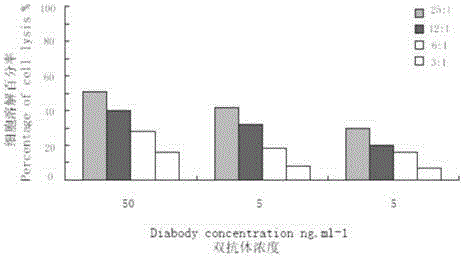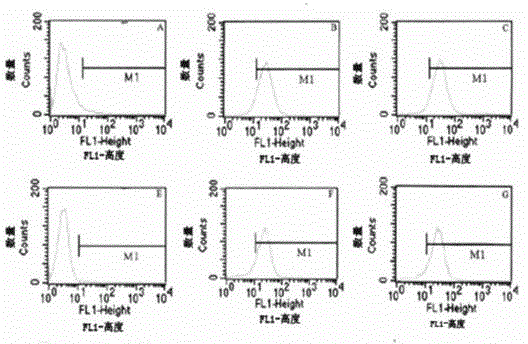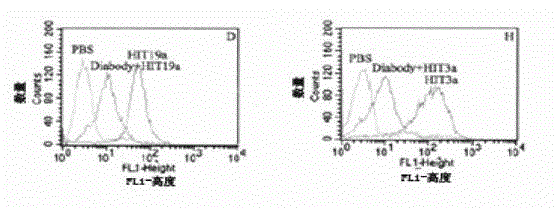Anti-CD3/anti-CD19 dual-specific antibody and application thereof
A bispecific antibody and single-chain antibody technology, applied in the field of anti-CD3/anti-CD19 bispecific antibody, can solve the problem of weakening the immune effect of tumors, and achieve the effect of avoiding side effects and high affinity
- Summary
- Abstract
- Description
- Claims
- Application Information
AI Technical Summary
Problems solved by technology
Method used
Image
Examples
Embodiment 1
[0031] Example 1: Obtaining of anti-human CD3 and CD19 single-chain antibodies
[0032] 1. Preparation of cDNA
[0033] Collect 10 ml of peripheral blood from 50 people with liver cancer, kidney cancer, melanoma, and healthy people, anticoagulate with sodium heparin, separate mononuclear cells (PBMC) by density gradient centrifugation, and sensitize with CD3 or CD19 antigen in vitro. After PBMC were sensitized in vitro, press 4×10 6 Add 1ml of EBV culture supernatant to PBMC, incubate at 37°C for 3h, discard the supernatant, add RPMI1640 complete medium containing 100ml / L FCS, and after 2 weeks of culture, replace with RPMI1640 complete medium containing 200ml / L NBS. The culture supernatant of transformed cells was screened by indirect ELISA method, CD3 or CD19 was used as the tumor cell antigen solid phase plate, the collected B cell culture supernatant was used as the primary antibody, and HRP-labeled goat anti-human IgG / M (HRP-GAH-IgG / M) as the secondary antibody. Cells...
Embodiment 2
[0045] Example 2: Expression and purification of single-chain bispecific antibodies against CD3 and CD19
[0046] The bispecific single chain antibody construct comprises the specific binding domains of human CD3 and human CD19, wherein the corresponding branchable heavy chain region (V H ) and the corresponding variable light chain region (V L ) from N-terminal to C-terminal in the following order: V H (CD19)-V L (CD19)-V H (CD3)-V L (CD3) or V H (CD3)-V L (CD3)-V H (CD19)- L (CD19).
[0047] 1. Expression of anti-CD3 / anti-CD19 mini bifunctional antibody. A single colony of Escherichia coli containing the recombinant plasmid was selected and inoculated into 2YT medium (1.6% tryptone, 1% yeast extract, 0.5% NaCl) containing ampicillin (0.1 mg / mL), and cultured with shaking at 37°C for 8 h, Transfer to Ap5 medium containing ampicillin (0.1mg / mL) at a ratio of 1:2 (0.6g / L yeast extract, 11g / L acid hydrolyzed casein, 1.5g / L glucose, 1.2g / L NaCl, 3.73g / L KCl, 1.07g / L NH...
Embodiment 3
[0055] Example 3: Determination of the binding activity of anti-CD3 / anti-CD19 bispecific antibody by indirect immunofluorescence
[0056] To test the function of the constructs with respect to CD19 and CD3 binding capacity, flow cytometry analysis (FACS) was performed. For this, CD19-positive Nalm6 cells (human B-cell precursor leukemia) and CD3-positive Jurkat cells (human T-cell leukemia) were used. Incubate 200,000 Nalm6 cells and 200,000 Jurkat cells with 50ul purified anti-CD3 / anti-CD19 bifunctional antibody on ice for 30min, centrifuge at 300×g, 4°C for 5min, discard the supernatant, wash the cells with cold PBS, repeat 3 times. Cells were incubated with mouse anti-His-tag monoclonal antibody (diluted 1:1000) for 1 h at 4°C, the antibody specifically binds to the cell-bound construct through the C-terminal histidine tag of the construct, 300×g, Centrifuge at 4°C for 5 minutes, discard the supernatant, wash the cells with PBS, and repeat 3 times to remove unbound mouse ...
PUM
 Login to View More
Login to View More Abstract
Description
Claims
Application Information
 Login to View More
Login to View More - R&D
- Intellectual Property
- Life Sciences
- Materials
- Tech Scout
- Unparalleled Data Quality
- Higher Quality Content
- 60% Fewer Hallucinations
Browse by: Latest US Patents, China's latest patents, Technical Efficacy Thesaurus, Application Domain, Technology Topic, Popular Technical Reports.
© 2025 PatSnap. All rights reserved.Legal|Privacy policy|Modern Slavery Act Transparency Statement|Sitemap|About US| Contact US: help@patsnap.com



